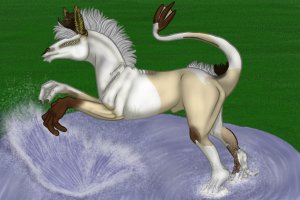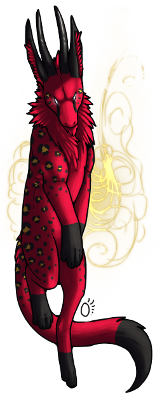This is the event page I'd like linked into first post so people are less likely to miss it if gets buried!
-Tephlan(teh-f-lan) | Medium to Large Species found on Vashta
The Tephlan are a medium to large species found on the planet Vashta. The Neravontii Agency had noticed the species while on Vashta to study the neravontii and deravontii from the area and upon arrival found this smaller species in the area as well. While they enjoy human contact they can be more bull headed and male tephlans experience major hormonal fluctuations around the spring season called Rut. Males in rut are very dangerous and unpredictable, but only lasts for 4 days a year. Pasturing a male in rut is advised to all owners!
Anatomy
When a baby tephlan, also known as a calf, is born they are around 63 centimeters tall and about 30 pounds. Calves take about an hour to run around and play with their litter mates. A female tephlans litter is normally 3 to 4 calves with record litters of 7. Baby tephlan are born with the darkest color of its coat covering its whole body with lighter horizontal striping on their body. As they grow they fade into adult color by 3 weeks of age losing the initial baby striping. At 3 weeks old female and male tephlans can be bred and males can go into rut.
Tephlan have smooth furry coats, along with a thick dorsal mane. Because of the lack of full lighting on their home planet they lack eyes and instead sport highly sensitive tufts of hair in their ears. These tufts sense shifts in their surroundings allowing them to "see". Panicked tephlan are known to run blindly and charge, as they run the tufts sensors don't have time to react fast enough essentially welding them blind. Sensor tufts don't grow back and can leave them visionless without it. The trunk of a tephlan can be used for breathing and also to get water from the ground to their mouth. Located on either side of the chest, the major airway tract for the tephlan can be closed to breath out of the trunk or open for heavy breathing. A tephlans tusks are much like a boars. Both female and male tephlan have tusks they can grow fairly large with age. Like the tusks, a tephlans spurs, located on the front legs, also grow but stop fairly short maxing out at 4 inches. Tephlan have a colorful furless patch on both sides of their head where eyes would be located allowing them to easily regulate heat in their body. In the winter this allows them to warm up and in summer to cool down. Because tephlans have fairly thick fur in the winter months they don't have to rely on heat regulating as much as a neravontii does, letting them easily fair in colder climates. Tephlans are moderately slow but very strong. An adult can easily carry 350 pound plus tack! Adults range around 130 centimeters up to 170 centimeters tall. Male tephlans experience major hormonal fluctuations around the spring season called Rut. Males in rut are unpredictable and should be put the pasture for 5 days to ensure rut behavior is out of their system. Males in rut are ready to breed and reproduce, from the start of the 4 days and 7 days after rut.
Eating Habits
Tephlan stick to vegetation when eating and are mainly herbivores. A tephlans favorite meal is the leaves off of trees they can reach. They are known to strip all the leaves in their enclosure when they are reachable. Maple leaves being the favorite. During harder times tephlan use their tusks to uproot plants and eat the roots and insects around the plants. Tephlans also start eating bark if no other food sources are available, so even prefer it as a treat and debark trees they fancy.
Vocalization
With a wide range of vocalizations, tephlans are very vocal. Squealing, snorting, and grunting are some of the most common vocal sounds made. Low grunting can signal a happy and content tephlan, while loud grunts can be a warning sign to an attack. Squealing, being the most popular noise, can mean a wide array of things. When not given in context squeals and snorts cant be determined as to what they mean.
Habitat
Tephlan have been found in all types of climates. From hot climates to cold climates they do very well in all climates. Tephlan in seasonal climates get a thick, woolly winter coat.
~ARTIST/GUEST ARTIST Coloring Rules~WIP
-Cows
- Code: Select all
[quote] [left][quote] [b]Owner >>>[/b] [size=95]x[/size]
[b]Name >>>[/b] [size=95]x[/size]
[b]Gender >>>[/b] [size=95]Cow[/size]
[b]Adult Height >>>[/b] [size=95]x[/size]
[b]Adoption Price >>>[/b] [size=95]x[/size]
[b]Training >>>[/b] [size=95]x[/size]
=====
[size=95] . x
. x
. x
. x
[/quote][/left][right][quote][b] Offspring[/b];
None
[/quote][/right]
[quote] [Discipline >>>>> ]
[Shows Entered > R: W: E:]
[Shows Won >>>> R: W: E:][/quote] [/quote]
-Gelded Males
- Code: Select all
[quote] [left][quote] [b]Owner >>>[/b] [size=95]x[/size]
[b]Name >>>[/b] [size=95]x[/size]
[b]Gender >>>[/b] [size=95]Castrated Bull[/size]
[b]Adult Height >>>[/b] [size=95]x[/size]
[b]Adoption Price >>>[/b] [size=95]x[/size]
[b]Training >>>[/b] [size=95]x[/size]
=====
[size=95] . x
. x
. x
. x
[Discipline >>>>> ]
[Shows Entered > R: W: E:]
[Shows Won >>>> R: W: E:][/quote] [/quote]
-Bulls
- Code: Select all
[quote] [left][quote] [b]Owner >>>[/b] [size=95]x[/size]
[b]Name >>>[/b] [size=95]x[/size]
[b]Gender >>>[/b] [size=95]Bull[/size]
[b]Adult Height >>>[/b] [size=95]x[/size]
[b]Adoption Price >>>[/b] [size=95]x[/size]
[b]Training >>>[/b] [size=95]x[/size]
=====
[size=95] . x
. x
. x
. x
[/size][size=150] [b]Rut Level: [b]x[/b][/size]
[/quote][/left][right][quote][b] Offspring[/b];
None
[b]Covers Left[/b];
- Open
- Open
[/quote][/right]
[quote] [Discipline >>>>> ]
[Shows Entered > R: W: E:]
[Shows Won >>>> R: W: E:][/quote] [/quote]














 ★
★ ★
★
 ★
★ ★
★ ★ ---
★ ---


